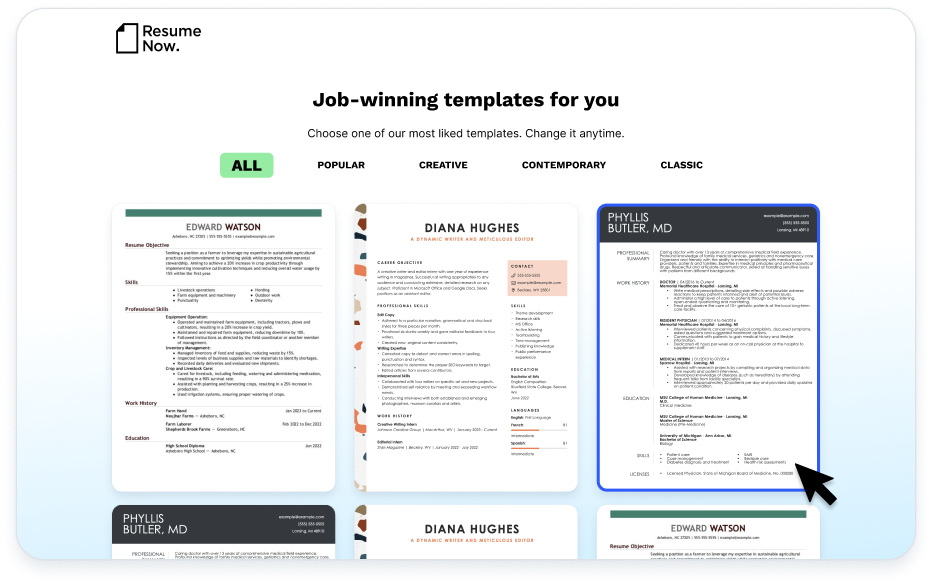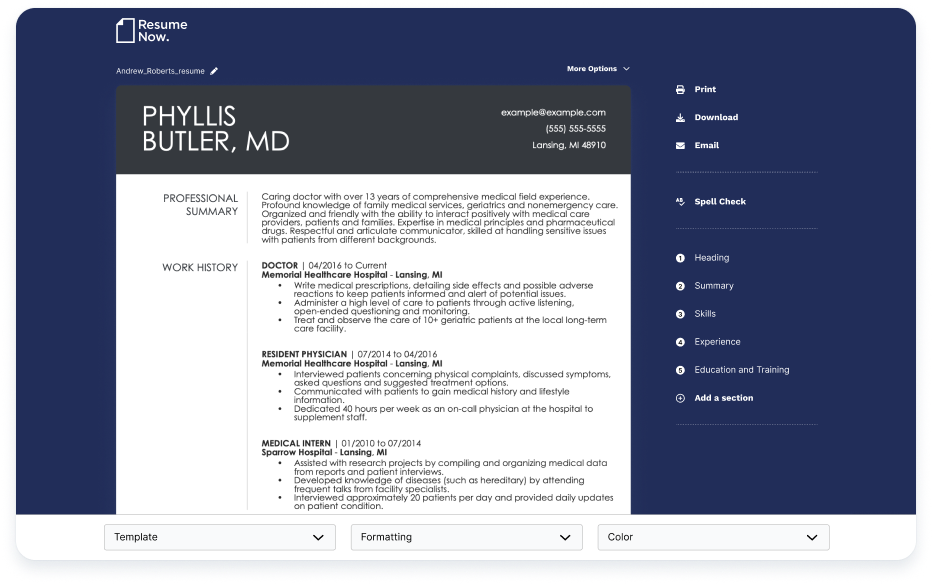Not sure whether you should build a resume that emphasizes experience or skills? Lucky for you, there’s a way to do both. The combination resume format blends elements of the chronological and functional resume formats to create a versatile resume layout that is appropriate for a variety of job seekers because it showcases both skills and work experience.
Many mid-career professionals want a resume that shows off both their career progression and the skills they have acquired along the way. This is what the combination resume format is for. But, this format is not for everyone. Here, we will cover the following topics to help you decide if this resume format is right for you:
- What is a combination resume?
- Who should use the combination resume format?
- A selection of combination resume templates and samples of combination resumes
- Tips for how to write a combination resume
- Frequently asked questions about the combination resume format
What is a combination resume?
A combination resume is one of the three types of resume formats. Sometimes called the hybrid resume, it combines features of the chronological resume format and functional resume format.
By featuring an extensive work experience section and a detailed skills section, it allows job seekers to equally highlight both their skills and work experience. Combination resumes are great for applicants with several years of relevant experience in the role they seek and with the skill set to match. Take a look at the combination resume sample below.
Structure of a combination resume


Who should use the combination resume format?
You should use the combination resume format to apply for a job if:
- You’re a mid-career professional.
- You have at least two years of relevant work experience.
- You can show a solid career trajectory.
- You have a steady work history with no significant gaps.
Pros and cons of using a combination resume:
Pros
- The hybrid resume displays a detailed work history to potential employers, making it easy for them to scan.
- It allows you to highlight key skills relevant to the role, which is especially useful when applying for jobs that require highly specialized skills.
- The combination resume layout provides structural flexibility, which allows you to customize your resume for different jobs.
- The combination resume format allows you to highlight the specialized training you’ve received. You can use the skills-focused sections to emphasize qualifications that aren’t necessarily tied to your work history.
Cons
- The combination resume is very detailed, making writing time-consuming. Using a professional resume builder will speed up the process.
- The level of detail this format includes can make it challenging to stick to the recommended resume length of one to two pages. Focus on including only your most relevant details to stay within the length limits.
- This format can be confusing if it’s not well-organized. Study our examples of resume formats to learn how to write a resume with clear headings that are easy to read.
For other examples of resume formats, see our chronological and functional format pages.
Combination resume template and examples
Free downloadable combination resume template
Using one of our premium or free combination resume templates is the easiest way to learn how to format a resume. To ensure your resume is properly formatted and organized, we offer resume templates in various styles, including modern, creative and simple designs.
Combination resume examples
From accounting to art, construction to communications, we have a resume example for any career that will show you how to stand out. Review our selection of hundreds of resume examples to find one for the job title you seek. Written by our team of certified resume writers, our samples of combination resumes show you what a strong resume should look like.
How to write a combination resume: Writing tips for every section
Tips for writing the resume header:
- Use your legal name.
- If it’s relevant to your career, include links to your portfolio website or LinkedIn account.
- Use a professional email address, ideally one that includes your name.
- Add your city and state but not your complete mailing address.
Tips for writing the professional summary:
- Focus on your most relevant skills and experience.
- Use data to highlight a professional accomplishment, such as “Improved website traffic by 36% in 2021.”
- Keep it short — three to five sentences are standard.
Tips for writing the summary of qualifications section:
- Keep it short and to the point — two to four sentences summarizing your most relevant skills and accomplishments will do. For example, “Proficient in Excel, Microsoft Word and Google Analytics.”
- Your summary of qualifications section should outline the most critical points in your work experience section.
- Only include skills and experience that relate directly to the role.
Tips for writing the skills section:
- Add any skills you possess that are listed in the job ad. These are deemed critical for success in the role.
- Include a mix of hard and soft skills. Soft skills are critical, even for roles that aren’t public-facing.
- Mention special skills and training, such as fluency in another language. This proficiency can set you apart from similarly qualified candidates.
Tips for writing the work experience section:
- Write a reverse-chronological list of your jobs, starting with your current role.
- Use data and metrics whenever possible since employers want to see the impact of your work.
- Avoid writing a dull list of day-to-day responsibilities and focus on achievements.
- Only include relevant roles. Skip adding a summer babysitting job, for example, unless it ties directly to the position.
Tips for writing the education section:
- List the exact title of your degrees or certifications and the name of any academic awards you received.
- Don’t add high school to this section unless it is your highest level of education.
- Be sure to highlight any academic awards you received.
- Don’t list your graduation dates unless you graduated within the last two years.
FAQ
A combination resume focuses on your skills and work accomplishments equally. While this format typically includes an education section, you should focus on creating strong skills and work experience sections, with your employment history and summary explaining how you’ve used your skills to make a positive impact.
It’s a matter of emphasis. While the combination format spotlights your skills and job history, a chronological resume focuses on work experience, and a functional format concentrates on relevant skills.
The combination resume format is well-suited for mid-career job candidates who might not have senior-level experience but can showcase career progression and essential skills. A combination resume is also a good choice for changing careers or industries because it highlights how your skills and professional accomplishments are interlinked with your new career.
When using this format, focus on your skills and work experience sections. Read through the job description, pick out key skills that fit your abilities, and add them to your resume, specifically when describing your work accomplishments. You can also list transferable skills from previous jobs and activities (such as volunteer work) relevant to the position you want.
Whether your resume follows a combination, chronological or functional format, employers appreciate those that present the candidate’s employment history and abilities clearly and accurately. Your resume should also indicate that you’ve taken the time to read up on the employer and the job and have matched your talents to what the job requires.
We strongly recommend against repeating your listed skills in your work history in a combination resume because it’s never a good idea to be redundant. Instead, show what you’ve achieved by using your skills in your previous positions through strong examples in your experience section.
According to our certified resume writers, including transferable skills in the combination resume format significantly improves your chances of getting an interview, especially if you are changing industries or jobs. Just make sure you list the required transferable skills you know you have and then provide examples of how you’ve used them. To make them stand out, also create a skills section called “transferable skills” in addition to a section called “technical skills” or “leadership skills,” depending on the job and your goals.
Yes! The combination resume format is the most versatile. Because the structure is relatively flexible, you have more options for customization with this format than with the chronological or functional formats. It’s also as suitable for senior-level professionals with steady career tracks as it is for mid-level workers who want to change industries or professions.
Was this information helpful? Let us know!
Hailey Brophy is an experienced writer with a diverse career in digital publication. She is passionate about using her unique skills and experiences to help job seekers find the information that they need to succeed.
Create a professional resume in minutes!

Get noticed
Choose from more than a dozen eye-catching professional design templates that will help you create a unique resume employers will notice.

Find the right words
Writing your resume is a snap — just use our pre-written text bullet points to showcase your skills and accomplishments.

Get step-by-step advice
We’re there for you, every step of the way. Our professional resume tips and guidance will save you time and help your resume stand out from the competition!

Format your finished resume
Our simple editing tools make it easy to get exactly the resume you want. Download in your choice of formats, then print and send as many copies as you need.
More resources

How to Write a Resume: Guide & Examples for 2025
If you re wondering how to write a resume that grabs attenti...

Should You Put Your Address on Your Resume? (Guide + 5 Example Resume Headers)
Should you put your address on your resume? We ll answer you...

Engineering Resume: Examples, Templates & Tips for 2025
Build an engineering resume that s bound to impress recruiters...

Stationary Engineer Resume: Examples, Templates & Tips for 2025
Boost your career as a stationary engineer with our expertly c...

Medical Technologist Resume: Examples, Templates & Tips for 2025
Make a medical technologist resume that gets interviews. Use o...

